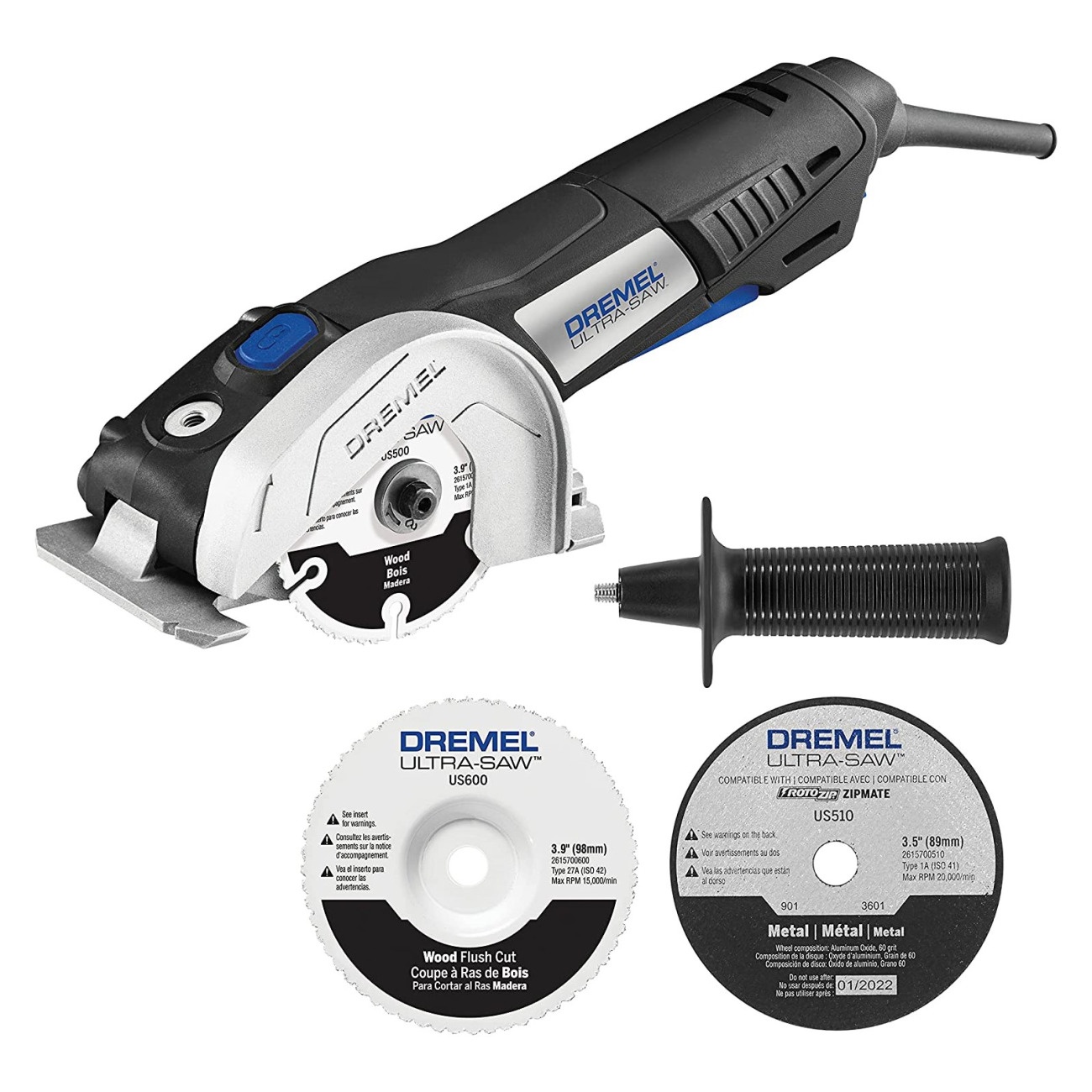Dremel DSM20 Saw Max
Highlights
Product attributes
Galleries
In the box
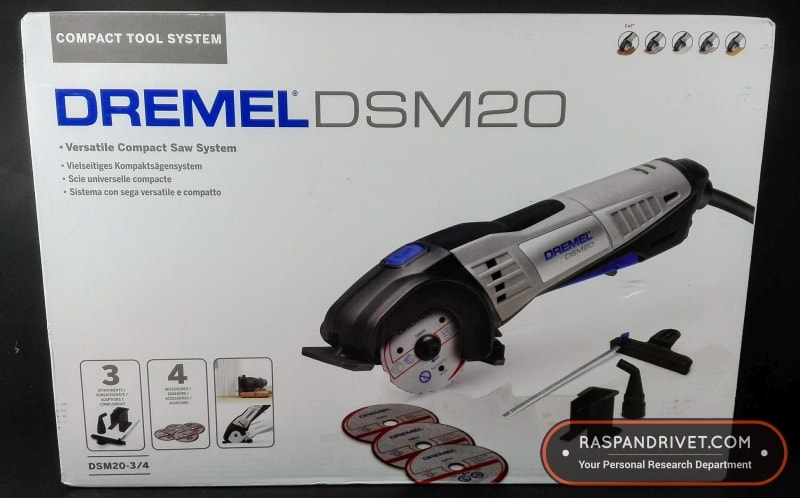 the dremel dsm20 saw max box
the dremel dsm20 saw max box the dremel dsm20 saw max carry case, closed
the dremel dsm20 saw max carry case, closed the dremel dsm20 saw max carry case, open
the dremel dsm20 saw max carry case, open dremel dsm20 saw max
dremel dsm20 saw max dremel saw max wood and pvc cutting disc
dremel saw max wood and pvc cutting disc dremel saw max metal cutting discs
dremel saw max metal cutting discs dremel saw max allen key
dremel saw max allen key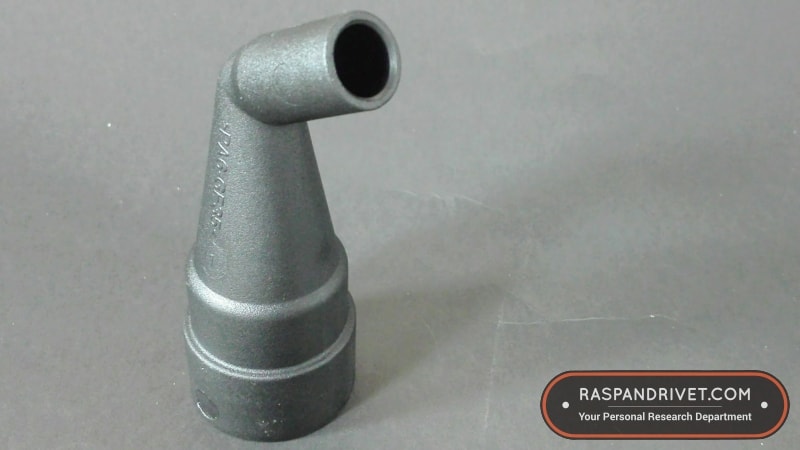 dremel saw max dust port adaptor
dremel saw max dust port adaptor dremel saw max 2x4 guide
dremel saw max 2x4 guide dremel saw max straight edge guide
dremel saw max straight edge guide dremel saw max instruction guide
dremel saw max instruction guide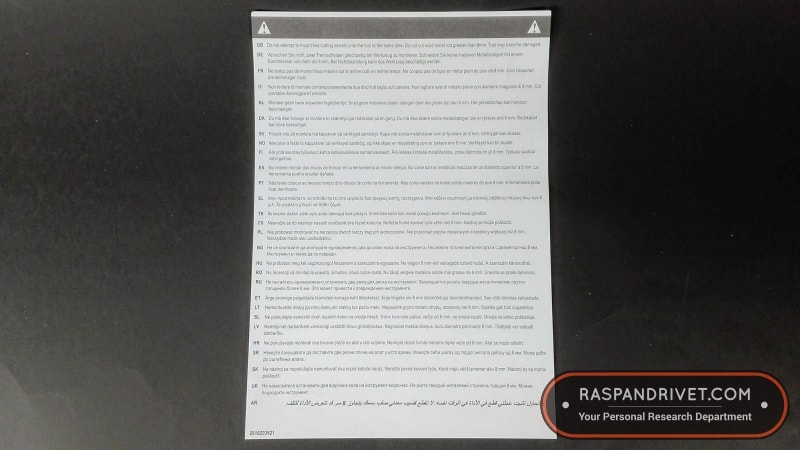 a warning to not use more than one disc at a time on the saw max, in various languages
a warning to not use more than one disc at a time on the saw max, in various languages dremel erratum
dremel erratumCut quality
 the new fine tooth jigsaw blade i used on the plywood
the new fine tooth jigsaw blade i used on the plywood the wood cutting disc i used on the plywood
the wood cutting disc i used on the plywood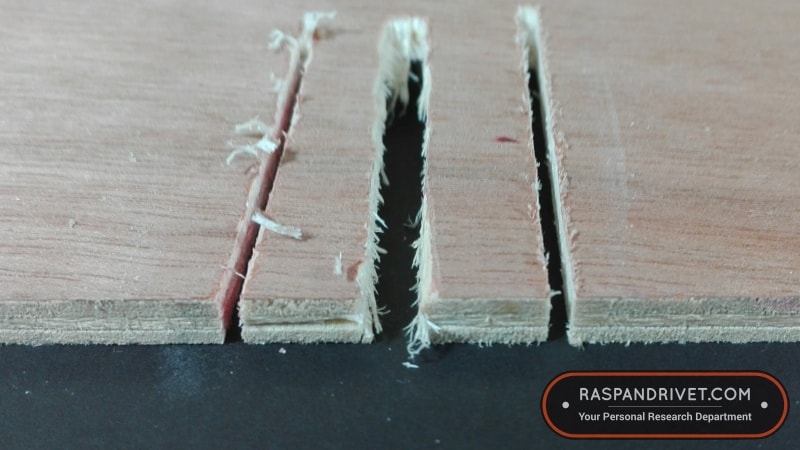 from left to right, the jigsaw, the angle grinder and the saw max
from left to right, the jigsaw, the angle grinder and the saw maxClean
 from left to right, the jigsaw, the angle grinder and the saw max
from left to right, the jigsaw, the angle grinder and the saw max the saw max cuts away from you, making for a much cleaner work session
the saw max cuts away from you, making for a much cleaner work sessionHow to use
 press and hold in the spindle lock
press and hold in the spindle lock the lock bolt
the lock bolt loosen the lock bolt
loosen the lock bolt the lock bolt removed, showing the outer washer
the lock bolt removed, showing the outer washer the outer washer removed, showing the inner washer
the outer washer removed, showing the inner washer located the cutting disc onto the inner washer, onto the spindle
located the cutting disc onto the inner washer, onto the spindle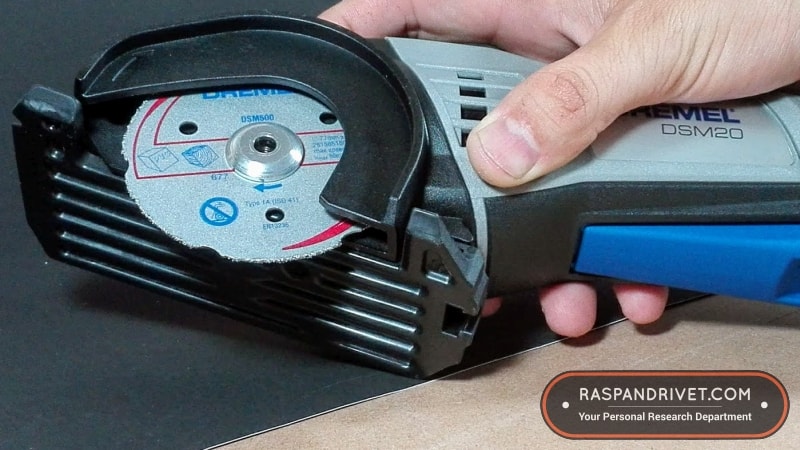 place the outer washer onto the cutting disc
place the outer washer onto the cutting disc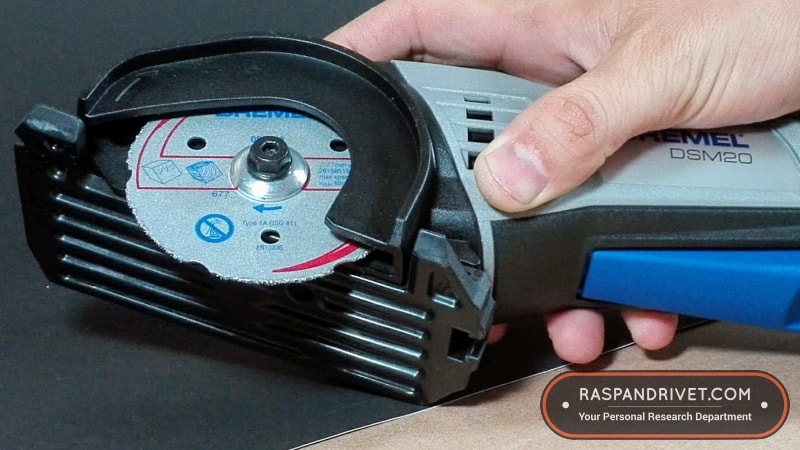 screw in the lock bolt
screw in the lock bolt tighten the lock bolt
tighten the lock bolt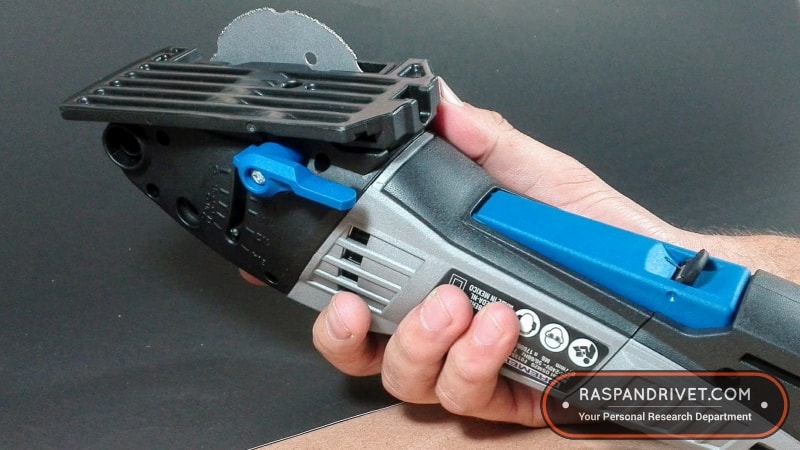 the saw max is ready to use. adjust your height and start cutting
the saw max is ready to use. adjust your height and start cuttingHow to use the straight edge guide
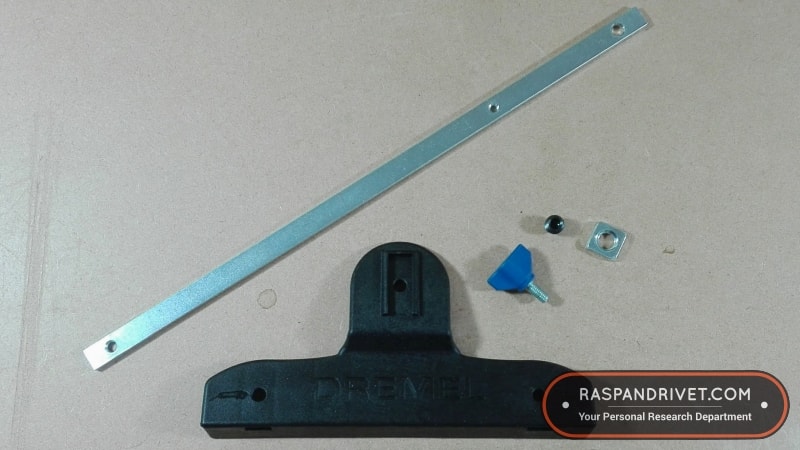 the dremel saw max straight edge attachment
the dremel saw max straight edge attachment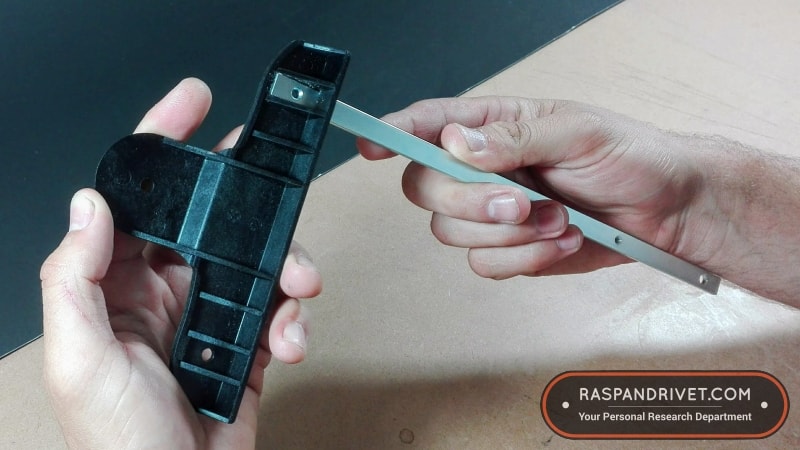 locate the metal rod into the slot on the plastic guide
locate the metal rod into the slot on the plastic guide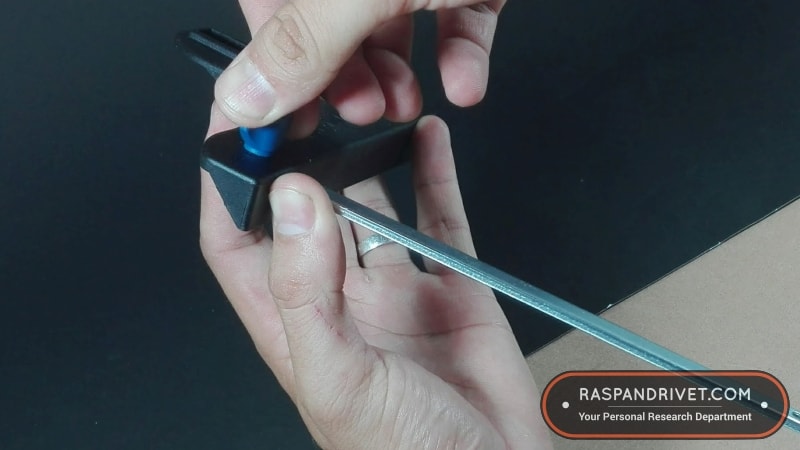 lock the metal rod in place with the wing screw
lock the metal rod in place with the wing screw the straight edge guide assembled
the straight edge guide assembled slide the assembled guide into the slot at the back of the dremel saw max
slide the assembled guide into the slot at the back of the dremel saw max insert the square lock nut into the dremel saw max
insert the square lock nut into the dremel saw max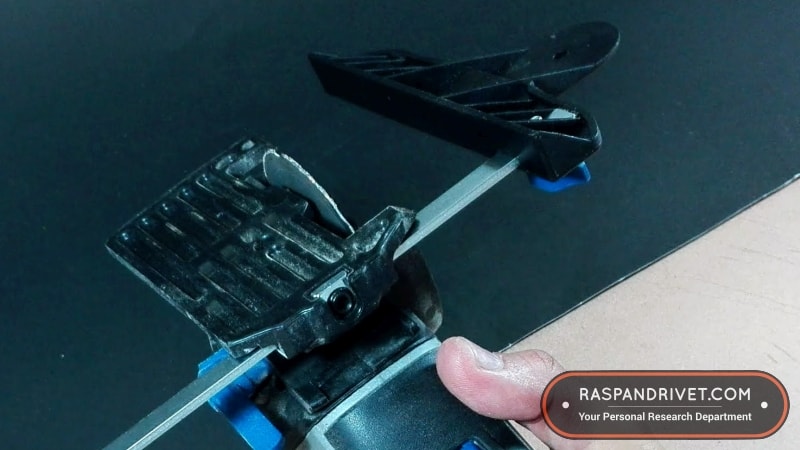 insert the set screw into the lock nut
insert the set screw into the lock nut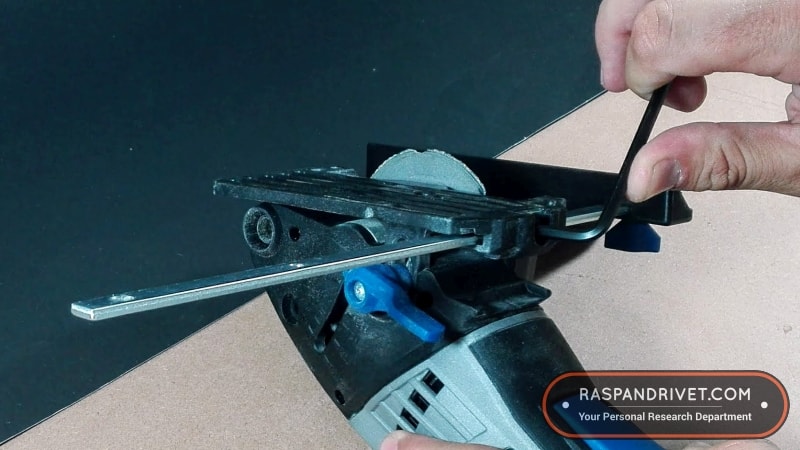 lock the set screw in place
lock the set screw in placeHow to use the 2x4 guide
 a piece of lumber i used for testing the 2x4 attachment
a piece of lumber i used for testing the 2x4 attachment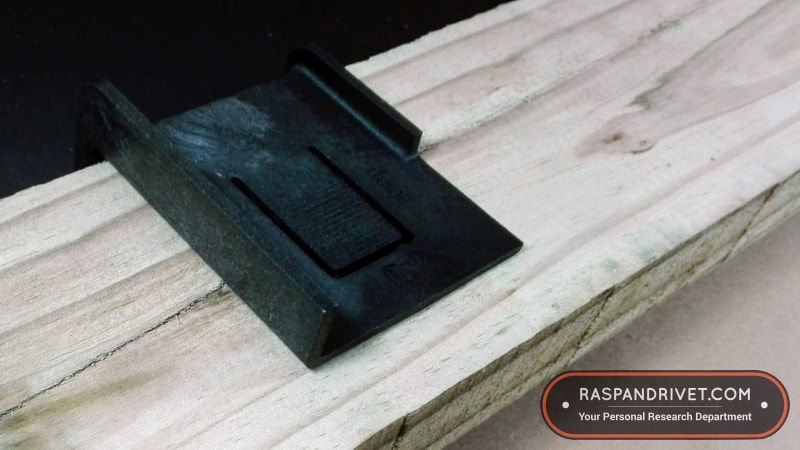 the 2x4 attachment on the lumber
the 2x4 attachment on the lumber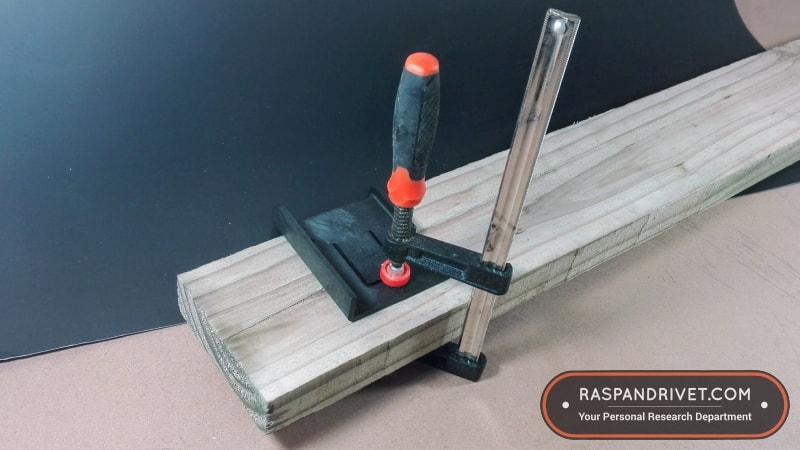 the 2x4 attachment clamped to the piece of lumber
the 2x4 attachment clamped to the piece of lumberWood
 40 pieces of 4mm plywood, 1220mm long x 610mm wide, cut from 10 sheets
40 pieces of 4mm plywood, 1220mm long x 610mm wide, cut from 10 sheets the dremel after cutting 36,600mm (1440.94 inches) of 4mm (0.16 inches) plywood. there's plenty of life left in the blade
the dremel after cutting 36,600mm (1440.94 inches) of 4mm (0.16 inches) plywood. there's plenty of life left in the bladePlastic
 the saw max had no trouble cutting the pvc pipe
the saw max had no trouble cutting the pvc pipeMetal
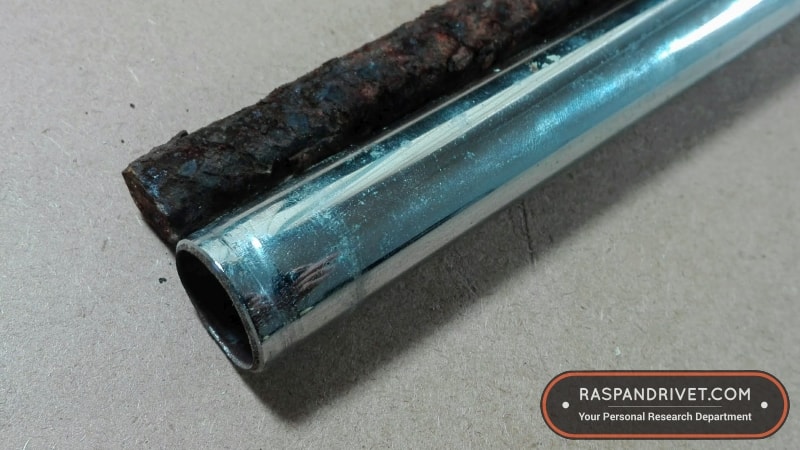 the rebar and metal tube i cut with the saw max
the rebar and metal tube i cut with the saw max off cuts from the rebar and metal tube
off cuts from the rebar and metal tubeI needed a tool for cutting plywood, so I bought a second-hand jigsaw. It was a disaster. So I got the Dremel DSM20 Saw Max, hoping it would do a better job. Read on to find out if it did.
I bought a second-hand jigsaw for cutting plywood for skimboards.
It’s a terrible tool for cutting thin sheets of wood, especially plywood, which it tears apart, even with a fine tooth blade. Using a jigsaw meant I had to cut a larger margin around the final part, which meant cutting it again after laminating.
That wouldn’t do.
I needed a unidirectional cutting tool that wouldn’t rip my plywood to pieces.
The ideal solution is a band-saw, but they’re expensive.
So my wife bought me a Dremel Saw Max for Christmas. (In some countries it’s coded SM20; in others, DSM20. It’s the same product.)
Here’s what I think of it…
Ease of use
The Saw Max is a joy to use.
Because of the adjustable foot, you set the cutting depth, place the Saw Max on the job and push.
At the front of the Saw Max is a small V cut into the plastic cover, called a line guide. Keep the line guide on the cutting line and you’ll cut straight.
To change the cutting disc, loosen the lock bolt (anti-clockwise) with the included Allen key, remove the old disc, insert a new disc, tighten, and go.
To set the Saw Max’s height, loosen the screw for the depth scale on the side of the tool, set the blade to the depth of cut (shown on the Saw Max), and lock it in place.
All of this takes seconds to perform, making the Saw Max a breeze to use.
Cut quality
The Saw Max gives a beautiful, clean cut.
Because the jigsaw cuts with a bidirectional action, it shakes the plywood this way, causing the wood to splinter. It looks like a shark used the board as a toothpick.
The Saw Max blade runs in a single direction, which means there’s less chatter in thin material. This translates to a smoother cut.
One tool that cuts as nicely as the Saw Max is the Gyokucho dozuki saw. It’s one of the best tools I’ve ever bought, but it has a different application. Even so, I recommend you get a dozuki too. (Read my review of the Gyokucho dozuki saw.)
The following pics show the difference in the cut between a jigsaw, an angle grinder, and the Saw Max.
Clean
A conventional angle grinder cuts towards you if you hold it in your right hand with the blade parallel to your body, its bottom facing left.
Try cutting plywood with this setup and see how long before you’ve had enough of chewing on splinters and dust.
The Saw Max cuts away from you, which means you’re not feasting on wood chips and dust.
Furthermore, the Saw Max comes with a vacuum cleaner attachment, which makes working with it much cleaner than working with an angle grinder.
Quick
I split ten 4mm (0.16 inches) plywood sheets into four. The cross-cut (1220mm / 48 inches) took 19 seconds, while the two rip cuts (total of 2440mm / 96 inches) took 15 seconds each.
That’s a total of 49 seconds per board (3660mm / 144 inches). That’s quick cutting.
There are tools that work quicker than that, but they won’t fit in a standard toolbox. Besides, the Saw Max is a joy to use.
Cutting disc info
The Saw Max comes with four discs: one for wood and PVC, the other three for metal.
However, there are five types of cutting discs in the range.
Cutting disc range
| Code | Description | Materials | Blade thickness | Diameter |
|---|---|---|---|---|
| DSM600 | Multi-purpose carbide flush cutting wheel | Drywall / plasterboard / fiberboard / hardwood / laminates / plastic / plexiglass / plywood / softwood / vinyl | 1.9 mm (0.07 inches) | 77 mm (3 inches) |
| DSM540 | Diamond tile cutting wheel | Brick / ceramic / drywall/plasterboard / floor tile / marble / porcelain / wall tile | ||
| DSM520 | Masonry cutting wheel | Brick / drywall / plasterboard | ||
| DSM510 | Metal and plastic cutting wheel | Aluminium / cast iron / copper / fiberboard / plastic / plexiglass / soft metal / vinyl | 1.27 mm (0.05 inches) | |
| DSM500 | Multi-purpose carbide cutting wheel | Drywall / plasterboard / fiberboard / hardwood / laminates / plastic / plexiglass / plywood / softwood / vinyl | 1.9 mm (0.07 inches) |
But they’re large, compared to some of Dremel’s other discs, some of which have a diameter of 34mm (1.3 inches).
Generic cutting discs
Dremel’s cutting discs are expensive, so I emailed abrasive disc manufacturers, asking whether they make a three-inch disc that’ll fit the Saw Max.
To give you an idea, here are some of the companies I emailed:
- Blacksmith.
- Bosch.
- Diacut.
- Draper.
- Everett.
- Fastflex.
- Fischer.
- Klingspor. (Danny Burnette at Klingspor USA gave exceptional service. He went out of his way to try and help me.)
- Metabo.
- Pferd.
- Ridgid.
- SIA.
- Tork Craft (Vermont Sales).
- Walter.
None of them has a disc that’ll fit the Saw Max.
You’re stuck using the Dremel brand since no one makes a disc with an 11mm (7/16 inches) bore.
There are generics available for other Dremel machines, but not for the Saw Max (yet).
Keep an eye on two companies if you want to buy generic blades for your Saw Max.
One is Tork Craft, and the other is Gyros Tools.
Neither have Saw Max blades yet, but I wouldn’t be surprised if they add it to their range.
Both of these companies make a range of cutting discs and accessories for Dremel’s other tools.
In the box
The Dremel DSM20 Saw Max box contains the following items:
- Plastic carry case.
- Dremel DSM20 Saw Max cutting tool.
- PVC and wood cutting disc (DSM500).
- Metal cutting disc (DSM510), (3 of).
- Dust port adaptor.
- Straight edge guide.
- 2×4 cutting guide.
- Allen Key.
- Usage guide and other paperwork.
How to use
Follow these ten steps to start using the Saw Max:
- Remove the Saw Max from the carry case.
- Press and hold down the spindle lock.
- Loosen the lock bolt.
- Remove the outer washer.
- Place the cutting disc onto the inner washer, on the spindle.
- Make sure it’s facing the right way.
- Place the outer washer onto the cutting disc.
- Screw in the lock bolt.
- Tighten the lock bolt.
- Adjust the cutting height.
- Cut.
How to use the straight-edge guide
Follow these steps to attach the straight-edge guide to your Saw Max:
- Locate the metal rod into the slot on the plastic guide.
- Lock the metal rod in place with the wing screw.
- Slide the assembled guide into the slot at the back of the Dremel Saw Max.
- Insert the square lock nut into the Dremel Saw Max.
- Insert the set screw into the lock nut.
- Lock the set screw in place.
The Saw Max labored through the lumber with this rip cut. Don’t use it on thick planks.
How to use the 2×4 guide
This add-on is useless, to be honest. I’d rather draw lines on a 2×4 or cut without a guide than go through the rigmarole of using this attachment.
Nevertheless, I thought I’d add it to the article to show you how it works.
You’re supposed to use a flush-cut disc for cutting (DSM600) with this attachment, but I don’t have it. I used the standard wood-cutting blade.
Cutting tests
I ran the Dremel through a few materials. Here’s how it fared…
Wood
I ordered ten 4mm (0.16 inches) sheets of plywood for making skimboards, but couldn’t get them cut at the factory on time. I could have arranged for another company to cut them for me but thought I’d try the Saw Max.
The sheets measure 2440mm x 1220mm (96 inches x 48 inches) and require two cuts each (or three cuts, depending on how you do it), to split them into four.
That’s a total of 36,600 mm (1440.94 inches) of plywood.
It took me half an hour to measure and cut the sheets. Cutting took less than 50 seconds per sheet.
Ceramics
I couldn’t test the Saw Max on tiles, since I don’t have the DSM520 masonry wheel. But if the Saw Max’s wood-cutting ability is anything to go by, it’ll run through tiles with ease.
Plastic
I bought a 40mm (1.57in) PVC pipe with a 2mm (0.078in) wall thickness, and made two cuts down the length of the pipe.
I’ve used two other tools for the same job before: a dozuki saw and a baby grinder with a cutting disc.
Both of them worked fine, but the Saw Max lets me set the depth of cut, which means I don’t have to worry about cutting through the other side of the pipe.
Metal
I cut two pieces of metal: a 19mm (0.75 inches) tube with a 1mm (0.03 inches) wall and a solid 12.5mm (0.49 inches) rebar rod.
The Saw Max handled the metal well, although you must take care to not overload the motor.
Price
The Dremel DSM20 Saw Max sells for just over $112 on Amazon.
If you use it as intended, it’ll give you hours of cutting pleasure. It’s worth every cent.
Replacement blades cost
Here’s what you’ll pay for Saw Max replacement blades:
- DSM500 – $6.97 (1 of).
- DSM510 – $9.97 (3 of).
- DSM520 – $4.20 (3 of).
- DSM540 – $23.38 (1 of).
- DSM600 – $10.49 (1 of).
Warranty
This, is from the Dremel SM20, Saw Max Amazon page…
Backed by a two-year warranty
That’s a decent warranty. To be expected from a company like Dremel.
Final thoughts
The Dremel DSM20 Saw Max is an excellent tool for cutting a variety of materials up to 20mm (0.787in) thickness. (Don’t cut metal 20mm thick; use a heavy-duty tool for that. The Saw Max handles metal rods of up to 8mm only.)
Here are six reasons why the Saw Max is fantastic…
It’s versatile. Cut wood, metal, plastic, brick, and tile with the Saw Max. The only limit is the thickness of the material you’re cutting.
It’s quick. The Saw Max runs through material quickly. It makes other cutting tools look bad.
It’s easy to use. Add a blade, set your height, and start cutting. It’s as simple as that.
It’s accurate. With an easy-to-follow line of sight and a thin kerf, the Saw Max gives you as accurate a cut as your hand and eye allow.
It’s smooth. Run a jigsaw through thin material once and you’ll not do it again. Because the Saw Max is a unidirectional tool, it doesn’t rip your job apart.
It’s clean. My baby angle grinder, when I use it with my right hand, rotates towards me. Have you any idea of the junk it dumps on you when you cut? The Saw Max cuts away from you, whether you use it with your right or left hand. Furthermore, the Dremel comes with a vacuum nozzle, which allows you to suck up shavings while you cut.
I love the Dremel Saw Max. It’s proving to be a must-have tool. I think you’ll like it too.
